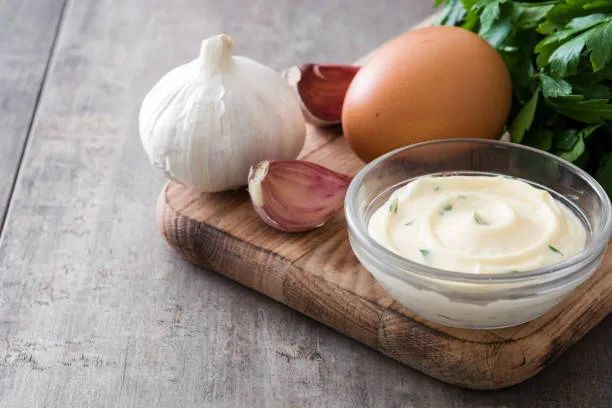Introduction
Alioli, often known as “aioli,” is a delectable Mediterranean sauce renowned for its creamy texture and bold garlic flavour. This versatile condiment serves as the perfect companion to an array of dishes, from grilled vegetables and seafood to meats and sandwiches. Its origins trace back to regions like Spain and Provence, where it has been cherished for generations. Making Alioli from scratch is a culinary adventure that yields a rich, homemade sauce far superior to store-bought alternatives.
In this easy-to-follow recipe, we’ll guide you through the steps to create your own homemade Alioli. With just a handful of simple ingredients and a bit of patience, you can whip up this delightful sauce to elevate your meals and awaken your taste buds. Whether you’re dipping, spreading, or drizzling, Alioli adds a burst of Mediterranean flavour that’s sure to impress.

Table of Contents
The Perfect Alioli
Here’s a basic recipe for making Alioli:
Ingredients:
- 4-6 garlic cloves (adjust to your preference for garlic intensity)
- 1 cup extra virgin olive oil
- 1 large egg yolk (at room temperature)
- 1 teaspoon Dijon mustard (optional)
- 1-2 teaspoons fresh lemon juice (adjust to taste)
- Salt, to taste
Instructions:

Prepare the garlic: Peel and finely chop the garlic cloves. If you prefer a milder garlic flavour, you can blanch the garlic cloves in boiling water for a minute and then shock them in ice water before using. This will help to tame the pungent raw garlic flavour.
Blend the garlic: Place the chopped garlic in a food processor or blender. You can also use a mortar and pestle if you prefer a more traditional method. Pulse the garlic until it becomes a fine paste.

Add the egg yolk: If using, add the egg yolk and Dijon mustard (if desired) to the food processor. Pulse to combine. The egg yolk helps emulsify the sauce and give it a creamy texture.
Slowly add the olive oil: With the food processor running, start adding the olive oil very slowly, in a thin, steady stream. Continue to blend until the mixture thickens and becomes creamy. This should take a few minutes.
Adjust the consistency: If the aioli is too thick for your liking, you can thin it out by adding a little lemon juice, one teaspoon at a time, and pulsing until you reach your desired consistency. The lemon juice also adds a pleasant tang to the sauce.
Season with salt: Taste the Aioli and season it with salt to your preference. You can also add more lemon juice if needed.
Serve: Transfer the Aioli to a serving bowl. It can be used immediately or stored in the refrigerator for a few days. It’s a great accompaniment for grilled meats, seafood, and vegetables, or as a dip for bread.
Conclusion

Alioli can be a bit finicky to make, as the emulsification process can sometimes fail. If your Aioli separates and becomes oily, you can try to rescue it by blending another egg yolk in a separate bowl and then slowly incorporating the broken Aioli into it while blending. If this doesn’t work, you may need to start over with fresh ingredients.
In summary, the perfect Alioli recipe is a simple yet flavourful masterpiece that elevates any dish. Its creamy texture and rich garlic essence make it a culinary gem worth mastering. With the right technique and attention to detail, you can create a homemade Alioli that’s truly exceptional. Enjoy the delightful Mediterranean flavours it brings to your table.

FAQs
Can I use a different type of oil besides olive oil?
Yes, you can use a different type of oil, but traditional Alioli is made with extra virgin olive oil, which gives it its distinct flavour. Using other oils will alter the taste of the sauce. You can experiment with different oils, but keep in mind that the flavour may not be authentic.
Is it safe to use raw egg yolk in Alioli?
The risk of foodborne illness from consuming raw egg yolk exists, but it can be minimised by using fresh, pasteurized eggs. Additionally, some people may choose to use pasteurized egg yolks or egg yolks from pasteurized eggs to reduce the risk further. If you’re concerned about using raw eggs, you can also try making a mayo-style Alioli without eggs.
Why did my Alioli turn out too thin or too thick?
Alioli consistency can vary depending on factors such as the speed at which you add the oil and the freshness of your ingredients. If it’s too thin, you can slowly add more oil to thicken it. If it’s too thick, you can thin it with a bit of lemon juice or water. The key is to add the oil gradually and consistently while blending.
Can I make Alioli without a food processor or blender?
Traditionally, Alioli is made using a mortar and pestle, which requires some elbow grease. You can certainly make it this way if you prefer a more hands-on approach. It may take longer, but the end result can be equally delicious.
How long can I store Alioli, and can it be frozen?
Alioli can be stored in an airtight container in the refrigerator for up to a week. It’s best to consume it within this time frame. Freezing Alioli is not recommended, as the emulsion may break upon thawing, resulting in a less appealing texture.



